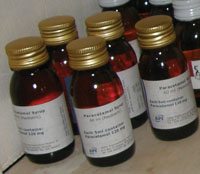Detecting discrepancies and explaining them
A discrepancy is a difference between what is reported and what is found. For example, imagine that 18 bottles of paracetamol syrup (Figure 6.6) were issued to a Health Post and entered into the stock register. After one month the Health Extension Worker took an inventory and found that she had issued nine bottles, but only five bottles remained. Four bottles were missing. This is a discrepancy in the stores.

Can you think of some possible explanations for this discrepancy?
You may have thought of several reasons, including:
- Perhaps the bottles were badly packed and were broken or lost.
- One of the Health Post staff may have been careless and broken the missing bottles and not reported it.
- The missing bottles may have been stolen.
If you find a discrepancy when you check your stores, it is important that you try to identify the cause and take appropriate actions.
Suppose you find out that a volunteer at the Health Post has broken the bottles, but was afraid to report it to you. What should you do? (Think back to Study Session 5.)
It is your responsibility to manage and improve the performance of this individual, by first discussing with them the circumstances in which the bottles were broken, and advising on how to prevent such an accident from happening again. Then you would discuss the reasons for reporting the breakage and encourage the volunteer to be honest with you about any such incident in the future. Remember to praise the person for admitting what happened and keep his or her performance under closer observation in future appraisals.